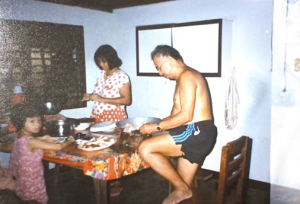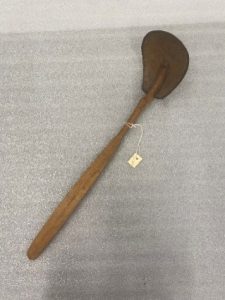Grandpa Buddy’s Story

While back in Pangasinan, my dad’s family bore a lot of struggles in the rural area of Mabini. However, my grandpa Buddy remained to flourish in the community for his cooking. Often using traditional means of firewood, steel calderos (pots), and hand-crafted cookware, which were all similarly found at the Burke. All of these were essential tools of my grandpa Buddy and made him the very chef and person he is remembered to be.

In light of talking to my dad about this cookware, he had told me about the craftsmanship and sourcing that each individual family in his barangay (neighborhood) had in making utensils for cooking. Tying to the Pangasinan spoon, “balaok”, at the Burke, it made me question the kinds of different techniques and materials each family had passed down in making their cookware: did they all differ in size and shape? Was one wood type better than another? Were there other materials other than coconuts and rattan that were pivotal in this process?
Particularly in my family, my grandpa Buddy was heavily detail-oriented and strict about the structure of his cookware. With the culture of customizing to the family, the extensive process for preparing community dishes suited him best. For example, he had specific angles and techniques in butchering all kinds of meat and kept to guava wood for sturdy handles when making his cookware.
Overall, with learning the meticulous process of crafting cookware and cooking in the rural parts of Philippines, I’ve learned that food shows a sense of investment that Filipinos are willing to grow from the ground up. In the act of harvesting, butchering, and actual cooking, it materializes love and gratitude for the place and people my grandpa Buddy (and all Filipinos) are surrounded with. As a whole, I’ve come realize that food and cooking is integral to Filipino identity in bringing community together both physically and emotionally, taking the active necessity of food into a place of living among struggle.

